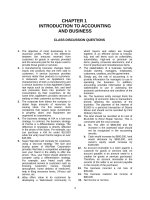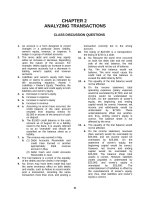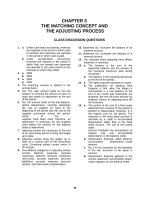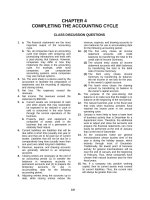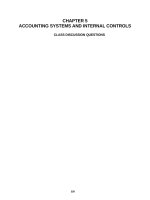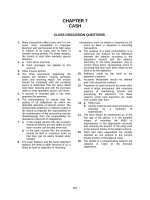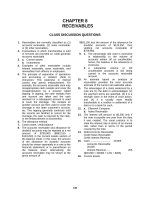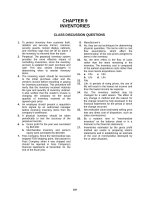Solution manual accounting 21e by warreni ch 16
Bạn đang xem bản rút gọn của tài liệu. Xem và tải ngay bản đầy đủ của tài liệu tại đây (165.24 KB, 50 trang )
CHAPTER 16
STATEMENT OF CASH FLOWS
CLASS DISCUSSION QUESTIONS
1. It is costly to accumulate the data needed.
2. It focuses on the differences between net
income and cash flows from operating
activities, and the data needed are
generally more readily available and less
costly to obtain than is the case for the
direct method.
3. In a separate schedule of noncash
investing
and
financing
activities
accompanying the statement of cash flows.
4. a. No effect
b. No
5. The $25,000 increase must be added to
income from operations because the
amount of cash paid to merchandise
creditors was $25,000 less than the
amount of purchases included in the cost
of goods sold.
6. The $10,000 decrease in salaries payable
should be deducted from income to
determine the amount of cash flows from
operating activities. The effect of the
decrease in the amount of salaries owed
was to pay $10,000 more cash during the
year than had been recorded as an
expense.
7. a. $5,000 gain
b. Cash inflow of $80,000
c. The gain of $5,000 would be deducted
from net income in determining net
cash flow from operating activities;
$80,000 would be reported as cash
flow from investing activities.
8. Cash flow from financing activities—
issuance of bonds, $5,250,000
9. a. Cash flow from investing activities—
disposal of fixed assets, $5,000
The $5,000 gain on asset disposal
should be deducted from net income in
determining cash flow from operating
activities under the indirect method.
b. No effect
10. The same. The amount reported as the net
cash flow from operating activities is not
affected by the use of the direct or indirect
method.
11. Cash received from customers, cash
payments for merchandise, cash payments
for operating expenses, cash payments for
interest, cash payments for income taxes.
12. Reported in a separate schedule, as
follows:
Schedule of noncash financing activities:
Issuance of stock for
acquisitions..........................$128 million
209
EXERCISES
Ex. 16–1
There were net additions, such as depreciation and amortization of intangible
assets of $10.2 billion, to the net loss reported on the income statement to
convert the net loss from the accrual basis to the cash basis. For example,
depreciation is an expense in determining net income, but it does not result in a
cash outflow. Thus, depreciation is added back to the net loss in order to
determine cash flow from operations.
The cash from operating activities detail is provided as follows for class
discussion:
AOL Time Warner
Cash Flows from Operating Activities
(selected from Statement of Cash Flows)
(in millions)
OPERATING ACTIVITIES
Net income (loss)................................................................................
Adjustments for noncash and nonoperating items:
Depreciation and amortization......................................................
Amortization of film costs.............................................................
Loss on writedown of investments..............................................
Net gains on sale of investments.................................................
Equity in losses of other investee companies net of cash
distributions.............................................................................
Changes in operating assets and liabilities, net of acquisitions:
Receivables....................................................................................
Inventories.....................................................................................
Accounts payable and other liabilities.........................................
Other balance sheet changes.......................................................
Cash provided by operating activities...............................................
$(4,921)
9,203
2,380
2,537
(34)
975
(484)
(2,801)
(1,952)
391
$ 5,294
Ex. 16–2
a.
b.
c.
d.
e.
f.
g.
h.
Cash receipt, $225,000
Cash receipt, $41,000
Cash payment, $120,000
Cash payment, $250,000
Cash receipt, $101,000
Cash payment, $37,500
Cash payment, $501,000
Cash payment, $30,000
Ex. 16–3
a.
b.
c.
d.
e.
f.
g.
h.
i.
j.
k.
investing
investing
financing
investing
operating
financing
financing
financing
investing
financing
financing
Ex. 16–4
a.
b.
c.
d.
e.
f.
g.
h.
i.
j.
added
added
deducted
deducted
deducted
added
added
added
added
deducted
k.
deducted
Ex. 16–5
a.
Cash flows from operating activities:
Net income....................................................
Add: Depreciation........................................ $53,500
Decrease in accounts receivable.......
1,600
Decrease in prepaid expenses...........
200
Increase in salaries payable...............
400
Deduct:
Increase in inventories........................ $13,300
Decrease in accounts payable...........
6,100
Cash from operations...................................
$255,800
55,700
$311,500
19,400
$292,100
b. Yes. The amount of cash flows from operating activities reported on the
statement of cash flows is not affected by the method of reporting such
flows.
Ex. 16–6
Cash flows from operating activities:
Net income.......................................................
Add: Depreciation........................................
Decrease in accounts receivable.......
Increase in wages payable..................
Deduct: Increase in inventories....................
Increase in prepaid expenses.........
Decrease in accounts payable.......
Cash from operations.....................................
$ 75,000
$22,500
3,700
3,000
$ 5,500
400
1,900
29,200
$104,200
7,800
$96,400
Ex. 16–7
Dividends declared............................................................
Add decrease in dividends payable.................................
Dividends paid to stockholders during the year.............
$80,000
5,000
$85,000
The company probably had four quarterly payments—the first one being $25,000
declared in the preceding year and three payments of $20,000 each—of dividends
declared and paid during the current year. Thus, $85,000 [$25,000 + (3 × $20,000)]
is the amount of cash payments to stockholders. The $20,000 of dividends
payable at the end of the year will be paid in the next year.
Ex. 16–8
Cash flows from investing activities:
Cash received from sale of equipment.......................
$25,000
[The gain on the sale, $5,000 ($25,000 proceeds from sale less $20,000 book
value), would be deducted from net income in determining the cash flows
from operating activities if the indirect method of reporting cash flows from
operations is used.]
Ex. 16–9
Cash flows from investing activities:
Cash received from sale of equipment.......................
$75,000
[The loss on the sale, $5,000 ($75,000 proceeds from sale less $80,000 book
value), would be added to net income in determining the cash flows from
operating activities if the indirect method of reporting cash flows from
operations is used.]
Ex. 16–10
Cash flows from investing activities:
Cash received from sale of land..................................
Less: Cash paid for purchase of land.........................
$310,000
300,000
(The gain on the sale of land, $60,000, would be deducted from net income in
determining the cash flows from operating activities if the indirect method of
reporting cash flows from operations is used.)
Ex. 16–11
Cash flows from financing activities:
Cash received from sale of common stock................
Less: Cash paid for dividends.....................................
$480,000
240,000
Note: The stock dividend is not disclosed on the statement of cash flows.
Ex. 16–12
Cash flows from investing activities:
Cash paid for purchase of land...................................
$290,000
A separate schedule of noncash investing and financing activities would report
the purchase of $200,000 land with a long-term mortgage note, as follows:
Purchase of land by issuing long-term mortgage note.....
$200,000
Ex. 16–13
Cash flows from financing activities:
Cash paid to redeem bonds payable...........................
Cash received from issuing bonds payable...............
$ 48,000
185,000
Note: The discount amortization of $1,200 and the loss on retirement of the
bonds of $2,000 ($48,000 less the bond carrying value of $46,000 on January 1)
would be shown as adjusting items (increases) in the cash flows from
operating activities section under the indirect method.
Ex. 16–14
Net cash flow from operating activities..............
Add: Increase in accounts receivable...............
Increase in prepaid expenses...................
Decrease in income taxes payable...........
Gain on sale of investments.....................
Deduct: Depreciation..........................................
Decrease in inventories.......................
Increase in accounts payable..............
Net income, per income statement......................
$105,700
$ 6,500
2,000
2,100
3,600
$11,000
6,400
4,700
14,200
$119,900
22,100
$ 97,800
Note to Instructors: The net income must be determined by working backward
through the cash flows from operating activities section of the statement of cash
flows. Hence, those items which were added (deducted) to determine net cash
flow from operating activities must be deducted (added) to determine net income.
Ex. 16–15
Cash flows from operating activities*:
Net income, per income statement......................
Add: Depreciation...............................................
Loss on sale of fixed assets.....................
Decrease in accounts receivable..............
Decrease in merchandise inventories......
Increase in accounts payable and other
accrued expenses..................................
Increase in income tax payable.................
Deduct: Increase in prepaid expenses...............
Other noncash income..........................
Cash from operations...........................................
*Dollars in thousands
$ 75,096
$81,594
3,950
6,025
33,793
4,156
12,145
$ 4,511
7,242
141,663
$216,759
11,753
$205,006
Ex. 16–16
a.
Sales............................................................................
Plus decrease in accounts receivable balance.........
Cash received from customers.................................
$510,000
27,000
$537,000
b.
Income tax expense....................................................
Plus decrease in income tax payable........................
Cash payments for income tax..................................
$ 29,000
3,900
$ 32,900
Ex. 16–17
Cost of merchandise sold.................................................
Add: Decrease in accounts payable.................................
Deduct: Decrease in merchandise inventories................
Cash paid for merchandise...............................................
$7,604*
274
(266)
$7,612
*In millions
Ex. 16–18
a.
Cost of merchandise sold..........................................
Add decrease in accounts payable...........................
Deduct decrease in inventories.................................
Cash payments for merchandise...............................
b.
Operating expenses other than depreciation...........
Add decrease in accrued expenses..........................
Deduct decrease in prepaid expenses......................
Cash payments for operating expenses...................
$450,000
4,700
$454,700
11,700
$443,000
$ 80,000
600
$ 80,600
1,000
$ 79,600
Ex. 16–19
Cash flows from operating activities:
Cash received from customers......................
Deduct: Cash payments for merchandise. . . $380,400 2
Cash payments for operating
expenses.................................... 150,6003
Cash payments for income tax.......
29,0004
Net cash flow from operating activities.........
$657,0001
560,000
$ 97,000
Computations:
1. Sales...................................................................................
Add decrease in accounts receivable..............................
Cash received from customers........................................
2. Cost of merchandise sold.................................................
Add: Increase in inventories...........................................
Decrease in accounts payable...............................
Cash payments for merchandise......................................
3. Operating expenses other than depreciation..................
Deduct: Decrease in prepaid expenses..........................
Increase in accrued expenses..........................
Cash payments for operating expenses..........................
4. Income tax expense...........................................................
Add decrease in income tax payable...............................
Cash payments for income tax.........................................
$645,000
12,000
$657,000
$367,800
$
4,200
8,400
12,600
$380,400
$155,400
$
2,500
2,300
4,800
$150,600
$ 25,400
3,600
$ 29,000
Ex. 16–20
Cash flows from operating activities:
Cash received from customers......................
Deduct: Cash payments for merchandise. . . $ 97,5002
Cash payments for operating
expenses.................................... 125,8003
Cash payments for income tax.......
12,300
Net cash flow from operating activities.........
$262,7001
235,600
Computations:
1. Sales........................................................................................................
Deduct increase in accounts receivable...............................................
Cash received from customers..............................................................
2. Cost of merchandise sold......................................................................
Add increase in inventories...................................................................
Deduct increase in accounts payable...................................................
Cash payments for merchandise...........................................................
3. Operating expenses other than depreciation........................................
Add decrease in accrued expenses......................................................
Deduct decrease in prepaid expenses..................................................
Cash payments for operating expenses................................................
$ 27,100
$265,000
2,300
$262,700
$ 95,800
5,300
$101,100
3,600
$ 97,500
$125,700
500
$126,200
400
$125,800
Ex. 16–21
CONTEMPORARY MILLWORKS INC.
Statement of Cash Flows
For the Year Ended December 31, 2006
Cash flows from operating activities:
Net income, per income statement........................
Add: Depreciation...................................................
Decrease in accounts receivable..................
Loss on sale of land......................................
Deduct: Increase in inventories.............................
Decrease in accounts payable.................
Net cash flow from operating activities.................
Cash flows from investing activities:
Cash received from sale of land............................
Less cash paid for purchase of equipment...........
Net cash flow used for investing activities...........
Cash flows from financing activities:
Cash received from sale of common stock...........
Less cash paid for dividends.................................
Net cash flow from financing activities.................
Increase in cash............................................................
Cash at the beginning of the year...............................
Cash at the end of the year..........................................
$30
$3
2
2
$5
3
7
$37
8
$29
$13
17
(4)
$12
3*
9
$34
16
$50
*$4 + $0 – $1 = $3
Ex. 16–22
1.
The increase in accounts receivable should be deducted from net income in
the cash flows from operating activities section.
2. The gain from sale of investments should be deducted from net income in the
cash flows from operating activities section.
3. The increase in accounts payable should be added to net income in the cash
flows from operating activities section.
4. Cash paid for dividends should be deducted from cash received from the sale
of common stock in the cash flows from financing activities section.
5. The correct amount of cash at the beginning of the year, $70,700, should be
added to the increase in cash.
6. The final amount should be the amount of cash at the end of the year, $96,100.
Ex. 16–22
Concluded
A correct statement of cash flows would be as follows:
HEALTHY CHOICE NUTRITION PRODUCTS, INC.
Statement of Cash Flows
For the Year Ended December 31, 2006
Cash flows from operating activities:
Net income, per income statement...................
Add: Depreciation.............................................. $ 49,000
Increase in accounts payable..................
4,400
Deduct: Increase in accounts receivable......... $ 10,500
Increase in inventories........................
18,300
Gain on sale of investments...............
5,000
Decrease in accrued expenses..........
1,600
Net cash flow from operating activities ...........
Cash flows from investing activities:
Cash received from sale of investments..........
Less: Cash paid for purchase of land.............. $ 90,000
Cash paid for purchase of equipment. . . 150,100
Net cash flow used for investing
activities........................................................
Cash flows from financing activities:
Cash received from sale of common
stock..............................................................
Less: Cash paid for dividends..........................
Net cash flow provided by financing
activities........................................................
Increase in cash......................................................
Cash at the beginning of the year..........................
Cash at the end of the year.....................................
$100,500
53,400
$153,900
35,400
$118,500
$ 85,000
240,100
(155,100)
$107,000
45,000
62,000
$ 25,400
70,700
$ 96,100
Ex. 16–23
Cash flows from operating activities
Less: Cash paid for common dividends
Cash paid for preferred dividends
Cash paid for maintaining property, plant, and equipment
Free cash flow
$120,000
20,000
8,000
27,000
$ 65,000
Supporting calculations:
Common dividends: 100,000 shares × $0.20 per share = $20,000
Preferred dividends: 1,000 × $100 × 8% = $8,000
Property, plant, and equipment to maintain productive capacity: $45,000 × 60% =
$27,000
Ex. 16–24
a. and b.
(all numbers in millions)
2003
2002
Sales...........................................................
$ 58,247
$ 53,553
Cash flows from operating activities........
Less: Capital expenditure to maintain
existing capacity:
Capital expenditures...................
Percent to maintain
productive capacity.............
Cash dividends..............................
Free cash flow............................................
$ 4,802
$ 5,963
Free cash flow as a percent of cash flows
from operating activities......................
Free cash flow as a percent of sales........
$2,749
× 20%
$3,393
(550)
(492)
$ 3,760
78.3%
6.4%
× 20%
(679)
(396)
$ 4,888
81.9%
9.1%
c. Home Depot has had strong free cash flows for both years. For example, the
free cash flow has been more than sufficient to fund store expansion (80% of
capital expenditures). However, the free cash flow for the year ended February
2, 2003, has dropped by 23% [($4,888 – $3,760)/$4,888] from the previous
year. In addition, the free cash flow as a percent of sales has also dropped
from 9.1% of sales to 6.4% of sales. The free cash flow as a percent of cash
flow from operating activities has remained near 80%. Thus, while the freecash-flow-generating ability of Home Depot is excellent, it has experienced
some deterioration in between the two years. The statement of cash flows
reveals that much of the decline in cash flows from operating activities was
caused by a significant increase in inventories during the year.
PROBLEMS
Prob. 16–1A
WINNER’S EDGE SPORTING GOODS, INC.
Statement of Cash Flows
For the Year Ended December 31, 2006
Cash flows from operating activities:
Net income, per income statement..............
Add: Depreciation........................................
Increase in accounts payable.............
Deduct: Increase in accounts receivable. .
Increase in inventories.................
Gain on sale of investments........
Decrease in accrued
expenses...............................
Net cash flow from operating activities......
Cash flows from investing activities:
Cash received from sale of investments....
Less: Cash paid for purchase of land.........
Cash paid for purchase of
equipment.....................................
Net cash flow used for investing
activities...................................................
Cash flows from financing activities:
Cash received from sale of
common stock.........................................
Less cash paid for dividends......................
Net cash flow provided by financing
activities...................................................
Increase in cash.................................................
Cash at the beginning of the year.....................
Cash at the end of the year...............................
*$56,000 + $10,000 – $14,000 = $52,000
$180,600
$ 26,000
18,200
44,200
$224,800
$ 17,500
27,100
12,000
4,900
61,500
$ 163,300
$132,000
$160,000
120,000
280,000
(148,000)
$105,000
52,000*
53,000
$ 68,300
395,800
$ 464,100
Prob. 16–1A
Concluded
WINNER’S EDGE SPORTING GOODS, INC.
Work Sheet for Statement of Cash Flows
For the Year Ended December 31, 2006
Transactions
Balance
Dec. 31, 2005
Cash...................................................
Accounts receivable.......................
Inventories........................................
Investments......................................
Land...................................................
Equipment........................................
Accumulated depreciation—
equipment...................................
Accounts payable............................
Accrued expenses...........................
Dividends payable...........................
Common stock.................................
Paid-in capital in excess of par—
common stock...........................
Retained earnings............................
Totals.................................................
Operating activities:
Net income..................................
Decrease in accrued expenses
Increase in accounts payable. .
Depreciation...............................
Gain on sale of investments....
Increase in inventories.............
Increase in accounts
receivable.............................
Investing activities:
Purchase of equipment.............
Purchase of land........................
Sale of investments...................
Financing activities:
Declaration of cash dividends
Sale of common stock..............
Increase in dividends payable
Net increase in cash........................
Totals.................................................
395,800
145,700
367,900
120,000
0
575,500
Debit
(m)
(l)
(k)
68,300
17,500
27,100
(i)
(h)
160,000
120,000
(168,000)
(210,500)
(21,400)
(10,000)
(60,000)
(e)
(175,000)
(960,000)
0
(b)
Credit
(j)
120,000
(g)
(f)
26,000
18,200
(d)
(c)
4,000
15,000
4,900
(c)
56,000 (a)
453,800
Balance
Dec. 31, 2006
464,100
163,200
395,000
0
160,000
695,500
(194,000)
(228,700)
(16,500)
(14,000)
(75,000)
90,000
(265,000)
180,600 (1,084,600)
453,800
0
(a) 180,600
(e)
(f)
(g)
18,200
26,000
(j)
(k)
12,000
27,100
(l)
17,500
(h) 120,000
(i) 160,000
(j) 132,000
(b)
56,000
(m)
68,300
465,800
(c) 105,000
(d)
4,000
465,800
4,900
Prob. 16–2A
MEDALIST ATHLETIC APPAREL CO.
Statement of Cash Flows
For the Year Ended December 31, 2006
Cash flows from operating activities:
Net income, per income statement................
Add: Depreciation..........................................
Increase in accounts payable..............
Decrease in accounts receivable.........
Deduct: Increase in merchandise
inventory.....................................
Increase in prepaid expenses ........
Net cash flow from operating activities.........
$ 61,500
$ 17,900
1,700
4,200
$ 5,400
1,500
6,900
$ 78,400
Cash flows from investing activities:
Cash paid for equipment................................
Net cash flow used for investing
activities.....................................................
Cash flows from financing activities:
Cash received from sale of common stock...
Less: Cash paid for dividends.......................
Cash paid to retire mortgage
note payable....................................
Net cash flow used in financing
activities.....................................................
Decrease in cash..................................................
Cash at the beginning of the year.......................
Cash at the end of the year..................................
23,800
$ 85,300
$ 47,500
(47,500)
$104,000
$48,000
95,000
143,000
(39,000)
$ (8,100)
45,300
$ 37,200
Prob. 16–2A
Concluded
MEDALIST ATHLETIC APPAREL CO.
Work Sheet for Statement of Cash Flows
For the Year Ended December 31, 2006
Transactions
Balance
Dec. 31, 2005
Cash...................................................
45,300
Accounts receivable.......................
65,400
Merchandise inventory...................
85,600
Prepaid expenses............................
4,000
Equipment........................................ 155,500
Accumulated depreciation—
equipment................................... (35,800)
Accounts payable............................ (65,400)
Mortgage note payable................... (95,000)
Common stock................................. (10,000)
Paid-in capital in excess of par—
common stock........................... (100,000)
Retained earnings............................ (49,600)
Totals.................................................
0
Operating activities:
Net income..................................
Increase in accounts payable. .
Depreciation...............................
Increase in prepaid expenses..
Increase in merchandise
inventory...............................
Decrease in accounts
receivables...........................
Investing activities:
Purchase of equipment.............
Financing activities:
Payment of cash dividends......
Sale of common stock..............
Payment of mortgage note
payable..................................
Net decrease in cash.......................
Totals.................................................
Debit
(j)
(i)
(h)
5,400
1,500
47,500
(g)
12,500
(d)
95,000
(b)
48,000
209,900
(a)
(e)
(f)
61,500
1,700
17,900
(k)
Credit
(l)
(k)
8,100
4,200
(g)
12,500
(f)
(e)
17,900
1,700
(c)
4,000
(41,200)
(67,100)
0
(14,000)
(c) 100,000
(a) 61,500
209,900
(200,000)
(63,100)
0
(i)
1,500
(j)
5,400
(h)
47,500
(b)
48,000
(d)
95,000
4,200
(c) 104,000
(l)
8,100
197,400
Balance
Dec. 31, 2006
197,400
37,200
61,200
91,000
5,500
190,500
Prob. 16–3A
SUNRISE JUICE COMPANY
Statement of Cash Flows
For the Year Ended, December 31, 2006
Cash flows from operating activities:
Net loss, per income statement...................
Add: Depreciation.......................................
Decrease in prepaid expenses..........
Loss on sale of land..........................
Deduct: Increase in accounts receivable
Increase in inventory....................
Decrease in accounts payable.....
Net cash flow from operating activities......
Cash flows from investing activities:
Cash received from land sold......................
Less: Cash paid for acquisition
of building.....................................
Cash paid for purchase
of equipment.................................
Net cash flow used for investing
activities...................................................
Cash flows from financing activities:
Cash received from issuance of
bonds payable.........................................
Cash received from issuance of
common stock.........................................
Less: Cash paid for dividends....................
Net cash flow provided by financing
activities...................................................
Decrease in cash................................................
Cash at the beginning of the year.....................
Cash at the end of the year...............................
$ (43,800)
$ 27,100
2,000
9,000
$ 18,400
25,400
3,500
38,100
$ (5,700)
47,300
$ (53,000)
$ 81,000
$250,000
32,900
282,900
(201,900)
$ 80,000
160,000
$ 240,000
12,000
228,000
$ (26,900)
432,100
$ 405,200
Prob. 16–3A
Concluded
SUNRISE JUICE COMPANY
Work Sheet for Statement of Cash Flows
For the Year Ended December 31, 2006
Transactions
Balance
Dec. 31, 2005
Debit
Credit
Cash...................................................
432,100
(o)
26,900
Accounts receivable.......................
305,700 (n) 18,400
Inventories........................................
576,900 (m) 25,400
Prepaid expenses............................
12,000
(l)
2,000
Land...................................................
190,000
(k)
90,000
Buildings...........................................
400,000 (j) 250,000
Accumulated depreciation—
buildings.....................................
(155,000)
(i)
17,500
Equipment........................................
210,700 (h) 32,900 (g)
18,000
Accumulated depreciation—
equipment...................................
(56,500) (g) 18,000 (f)
9,600
Accounts payable............................
(402,600) (e)
3,500
Bonds payable.................................
0
(d)
80,000
Common stock.................................
(50,000)
(c)
10,000
Paid-in capital in excess of par—
common stock...........................
(200,000)
(c) 150,000
Retained earnings............................ (1,263,300) (a) 43,800
(b) 12,000
Totals.................................................
0
404,000
404,000
Operating activities:
Net loss.......................................
Decrease in accounts payable.
Depreciation—equipment.........
Depreciation—buildings...........
Loss on sale of land..................
Decrease in prepaid expenses
Increase in inventories.............
Increase in accounts receivable
Investing activities:
Purchase of equipment.............
Acquisition of building.............
Sale of land.................................
Financing activities:
Payment of cash dividends......
Issuance of bonds payable......
Issuance of common stock......
Net decrease in cash.......................
Totals.................................................
(f)
(i)
(k)
(l)
(a)
(e)
43,800
3,500
(m)
(n)
25,400
18,400
9,600
17,500
9,000
2,000
(h) 32,900
(j) 250,000
(k)
81,000
(b)
(d) 80,000
(c) 160,000
(o) 26,900
386,000
12,000
386,000
Balance
Dec. 31, 2006
405,200
324,100
602,300
10,000
100,000
650,000
(172,500)
225,600
(48,100)
(399,100)
(80,000)
(60,000)
(350,000)
(1,207,500)
0
Prob. 16–4A
VILLAGE MARKETS, INC.
Statement of Cash Flows
For the Year Ended December 31, 2007
Cash flows from operating activities:
Cash received from customers...................
$4,336,3001
Deduct: Cash payments for
merchandise............................ $2,552,9002
Cash payments for operating
expenses.................................. 1,263,2003
Cash payments for income tax....
175,000
3,991,100
Net cash flow from operating activities......
$ 345,200
Cash flows from investing activities:
Cash received from sale of investments....
Less: Cash paid for purchase of land......... $ 230,000
Cash paid for purchase of
equipment.....................................
140,000
Net cash flow used for investing activities.
Cash flows from financing activities:
Cash received from sale of common stock
Less: Cash paid for dividends....................
Net cash flow used for financing
activities...................................................
Decrease in cash................................................
Cash at the beginning of the year.....................
Cash at the end of the year...............................
$ 150,000
370,000
(220,000)
$
78,000
238,000*
(160,000)
$ (34,800)
456,700
$ 421,900
Reconciliation of Net Income with Cash Flows from Operating Activities:
Net income, per income statement..............
$330,300
Add: Depreciation.......................................
$ 47,600
Increase in accounts payable............
14,900
Loss on sale of investments.............
25,000
87,500
$417,800
Deduct: Increase in accounts receivable
$ 31,500
Increase in inventories.................
35,800
Decrease in accrued expenses....
5,300
72,600
Net cash flow from operating activities......
$345,200
*Dividends paid: $241,000 + $58,000 – $61,000 = $238,000
Prob. 16–4A
Continued
Computations:
1. Sales................................................................................
Deduct increase in accounts receivable.......................
Cash received from customers......................................
2. Cost of merchandise sold..............................................
Add increase in inventories...........................................
$4,367,800
31,500
$4,336,300
Deduct increase in accounts payable............................
Cash payments for merchandise...................................
$2,532,000
35,800
$2,567,800
14,900
$2,552,900
3. Operating expenses other than depreciation................
Add decrease in accrued expenses...............................
Cash payments for operating expenses........................
$1,257,900
5,300
$1,263,200
Prob. 16–4A
Continued
VILLAGE MARKETS, INC.
Work Sheet for Statement of Cash Flows
For the Year Ended December 31, 2007
Transactions
Balance
Dec. 31, 2006
Balance Sheet
Cash...................................................
456,700
Accounts receivable.......................
365,700 (p)
Inventories........................................
623,100 (o)
Investments......................................
175,000
Land...................................................
0 (n)
Equipment........................................
450,000 (m)
Accumulated depreciation.............
(234,500)
Accounts payable............................
(456,300)
Accrued expenses...........................
(45,300) (k)
Dividends payable...........................
(58,000)
Common stock.................................
(20,000)
Paid-in capital in excess of par—
common stock...........................
(120,000)
Retained earnings............................ (1,136,400) (h)
Totals.................................................
0
Debit
Credit
Balance
Dec. 31, 2007
(q)
34,800
(e)
175,000
(c)
(l)
47,600
14,900
(j)
(i)
3,000
3,000
421,900
397,200
658,900
0
230,000
590,000
(282,100)
(471,200)
(40,000)
(61,000)
(23,000)
(i)
75,000
241,000 (g) 330,300
683,600
683,600
(195,000)
(1,225,700)
0
31,500
35,800
230,000
140,000
5,300
Prob. 16–4A
Concluded
Transactions
Balance
Dec. 31, 2006
Income Statement
Sales..................................................
Cost of merchandise sold..............
Depreciation expense.....................
Other operating expenses..............
Loss on sale of investments..........
Income tax........................................
Net income........................................
Cash Flows
Operating activities:
Cash received from customers
Cash payments:
Merchandise...............................
Balance
Dec. 31, 2007
(b) 2,532,000
(c)
47,600
(d) 1,257,900
(e)
25,000
(f)
175,000
(g)
330,300
(a)4,367,800
(l)
Income taxes..............................
Financing activities:
Declaration of cash dividends
Increase in dividends payable
Issuance of common stock......
Net decrease in cash.......................
Totals.................................................
Credit
(a) 4,367,800
Operating expenses..................
Investing activities:
Purchase of equipment.............
Sale of investments...................
Purchase of land........................
Debit
(e)
(j)
(i)
(q)
(p)
14,900 (b) 2,532,000
(o)
35,800
(d) 1,257,900
(k)
5,300
(f)
175,000
(m)
140,000
(n)
230,000
(h)
241,000
150,000
3,000
78,000
34,800
9,016,300
9,016,300
31,500
Prob. 16–5A
WINNER’S EDGE SPORTING GOODS, INC.
Statement of Cash Flows
For the Year Ended December 31, 2006
Cash flows from operating activities:
Cash received from customers......................
$1,563,0001
2
Deduct: Cash payments for merchandise..... $966,200
Cash payments for operating
expenses...................................... 334,3003
Cash payments for income tax........
99,200
1,399,700
Net cash flow from operating activities.........
$ 163,300
Cash flows from investing activities:
Cash received from sale of investments.......
Less: Cash paid for land................................ $160,000
Cash paid for equipment...................... 120,000
Net cash flow used for investing activities.. .
Cash flows from financing activities:
Cash received from sale of common stock...
Less: Cash paid for dividends.......................
Net cash flow provided by financing
activities.....................................................
Increase in cash....................................................
Cash at the beginning of the year.......................
Cash at the end of the year..................................
$ 132,000
280,000
(148,000)
$ 105,000
52,0004
53,000
$ 68,300
395,800
$ 464,100
Reconciliation of Net Income with Cash Flows from Operating Activities:
Net income, per income statement................
$ 180,600
Add: Depreciation........................................... $ 26,000
Increase in accounts payable................
18,200
44,200
$ 224,800
Deduct: Increase in accounts receivable...... $ 17,500
Increase in inventories.....................
27,100
Gain on sale of investments............
12,000
Decrease in accrued expenses........
4,900
61,500
Net cash flow from operating activities.........
$ 163,300
Prob. 16–5A
Continued
Computations:
1. Sales................................................................................ $ 1,580,500
Deduct increase in accounts receivable.......................
17,500
Cash received from customers...................................... $ 1,563,000
2. Cost of merchandise sold.............................................. $
Add increase in inventories...........................................
$
Deduct increase in accounts payable............................
Cash payments for merchandise................................... $
957,300
27,100
984,400
18,200
966,200
3. Operating expenses other than
depreciation............................................................... $
Add decrease in accrued expenses...............................
Cash payments for operating expenses........................ $
329,400
4,900
334,300
4. Cash dividends declared................................................ $
Deduct increase in dividends payable...........................
Cash paid for dividends................................................. $
56,000
4,000
52,000

